A Fifty Year Report on Rhododendrons
In Western Pennsylvania
1928-1978
Orlando S. Pride, Butler, PA
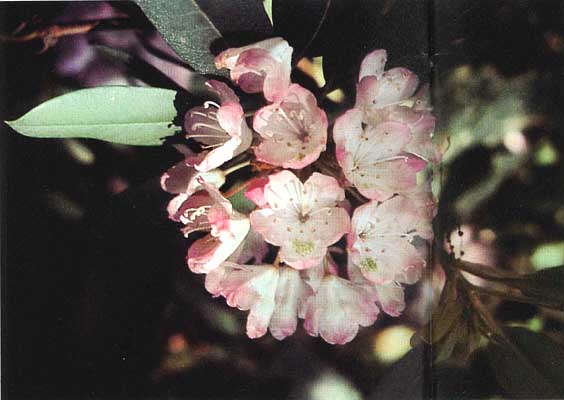
|
|
R. 'Arthur Pride'
Photo by Arthur Pride |
Back in 1928 when I was studying landscape architecture at Pennsylvania State University, hybrid rhododendrons were scarcely mentioned in our courses on ornamental horticulture. To the best of my knowledge, none were planted on the campus.
It was a fraternity brother and fellow classmate in landscape architecture, Charles Robinson, who introduced me to American holly and a few hybrid rhododendrons. Chuck also told me about a man named Joseph Gable of Stewartstown, PA., who had some large size azaleas and many rhododendrons. This information paved the way for my first stroke of luck - meeting Joseph Gable. How carefully he inoculated me with the fever! My brother, Arthur, was living then, and Joe Gable (Joe as he was known to us) sent us to Guy Nearing where we purchased our first cutting grown rhododendron, 'English Roseum'. This was about 1933 or 1934.
As I recall, hardly any nurseries had hybrid rhododendrons, and what they did have were ungainly looking grafted plants. No one had good looking, well foliaged plants. Not long after visiting Guy Nearing, I purchased my first plants from Joe: 'Catalode' A. E., 'Caroline', and a number of hybrid seedlings which he thought I should try. The one seedling which I still prize is a very red flowered
R. maximum
x
R. haematodes
, a sister seedling of 'Maxhaem Salmon'. After comparing this seedling with others of the group, I have concluded that the one Joe let me have is the best of the lot. It was the most beautifully foliaged and compact rhododendron I had ever seen. Well, I planted it down in a hollow where I thought it would be protected, but late frosts were very hard on it, and as a result, the plant was almost lost. Fortunately, I rooted a few cuttings and have made them available to areas with milder climates. Out of the hundreds of Gable's plants which I have tried, I think 'Catalode' A. E. (County of York) and 'Caroline' have been the most successful. Both of these rhododendrons have been growing for me for over 25 years and have never been injured even at -28° F. Both are bud hardy to about -15° F. Joe, of course, gave me my start with breeding hardy rhododendrons with a plant of 'Catalgla', a selected seedling of
R. catawbiense
var.
album
, which is even hardier, and many other basic plants.
Shortly after leaving Penn State and living in Butler, I learned that a neighboring nurseryman was layering rhododendrons growing in the old North Cemetery. This was the first time that I was aware of these beautiful plants. Warren Stokes had broken the ice with the old superintendent who had not permitted anyone to touch the plants. It was Warren who layered them and gave some of the layers back to the cemetery, and planted them for the cemetery. It was a fortunate arrangement for both the cemetery and Warren.
From this beginning, Warren grew thousands of seedlings from these old plants in the North Cemetery. As I recall, I don't think that Warren actually made any crosses in the early days. He simply grew thousands of seedlings and selected the best for further propagation. Once he found a good seedling, he would grow a large population from this selected seedling. He did this for years, and slowly progressed, producing a very hardy race of rhododendrons, with very good habit and foliage. Only a very few of these were very outstanding as to flower color. Some of Warren's work is being continued by Weldon Delp of Harrisville, Pa., who has grown on a number of these seedlings and has a few that are quite good. Also, Robert Danik of Valencia, Pa., has a very fine row of these hybrids, one of which is an outstanding pink. One of the original rhododendrons at the cemetery is an unusual deep wine color. We never could find the correct name, if it were ever named. However, we call it Butler Port. From Butler Port, Warren obtained a very stunning seedling which he named 'Newport'. It is not quite bud hardy enough for me. Warren also grew thousands of Mollis azalea seedlings which he crossed with the native azalea
R. nudiflorum
. These produced many beautiful colors, but the plants seemed to lack vigor and many of them dwindled away. I never had a good Mollis hybrid. Warren did have some very fine
R. luteum
and
R. calendulaceum
hybrids. I gave him pollen of the Exbury hybrid 'J. Jennings' which had done very well for me. The result was some very fine red hybrids. William Fetterhoff of Gibsonia, Pa. is continuing the work with these deciduous hybrids.
About 1950, Joe Gable told me about a fellow named David Leach who lived at Brookville, Pa., which is a very cold area, about sixty-five miles from Butler. Well, after meeting Dave, it was not long before I realized how much I had to learn concerning rhododendrons. Dave was just then writing his book,
Rhododendrons of the World
. Fortunately for me, Dave has been a good teacher. It was not until after I met Dave that I really began actively hybridizing rhododendrons. He was the one who showed me the technique for making crosses and made me aware of the hundreds of species and the thousands of named hybrids which could be used in a breeding program. Each year, I would visit his garden at Brookville and see new and outstanding rhododendrons. He gave me many of my parent stock plants, such as 'LaBar's White', 'Russell Harmon', 'Swansdown', 'Lodestar', 'Great Lakes', 'Tahiti', 'Duet', 'Pink Flourish', Mist Maiden, 'Pink Parasol'; and the following Dexter Hybrids: BPPM # 10, BPPM #4, BPPM #11, BPPM #29, Fowle 19, and the Bosley Dexters, BD 1005; BD 1009, BD 1020, BD 1021, BD 1035, BD 1024, and 'Brown Eyes'.
Of the above hybrids, the following have been the most bud hardy and successful for our area: 'Russell Harmon', 'Swansdown', 'Lodestar', 'Great Lakes', 'Mist Maiden', 'Pink Parasol', and BPPM # 10. And so it was these plants which were first used in my hybridizing.
One of my earliest crosses was 'Mrs. 'C. S. Sargent' x 'Lodestar' which gave me a very hardy pink. I also crossed 'America' with 'La Bar's White'. The results were some very vigorous plants with good foliage, but somewhat open growing. All had fairly good pink flowers, one of which I think is as good as 'Pinnacle', but a better performer. About this time, the late Sam Baldanza of Benton Harbor, Michigan, sent me a seed of 'America' x 'Mars', which in turn gave me my first step forward for a better red. I named one seedling 'Red Brave', one 'Roman Candle', and others Number 65-1, 66-1, and 67-1. The severe winter of 1977 injured all but 65-1, and 67-1 and I have decided not to register the two named clones.
I forgot to mention that Dave Leach also gave me a number of seedlings which were sister seedlings of 'Blaze' (
R. catawbiense
'Rubrum' x 'Mars'). A number of these have turned out to have better flowers for me than 'Blaze'.
While Dave was still living in Brookville, he flowered a beautiful dwarf red, a hybrid of 'Fanfare' x 'Gertrude Schale'. Pollen of this was put on hybrids of 'America' x 'Mars' and the result was a number of very fine reds, none of which root easily. These advanced red hybrids were then crossed with Dave's 'Singapore' and the result has been some very outstanding reds that are vigorous, with good foliage, and bud hardy to -28° F. None of these roots easily.
About twenty years ago, Dave invited me to go along up to the Cleveland area to see Tony Shamarello's early flowering rhododendrons. It was a beautiful day, about May 15th or earlier. John Wister and Warren Baldsiefen were also there. Tony had the welcome mat out and we all had a wonderful lunch prepared by his mother. Everything was simply delicious and I considered it to be a banquet. We spent most of the afternoon evaluating Tony's new introductions. These hybrids of 'Cunningham's White' and 'Boule de Neige' were the first early flowering rhododendrons developed for the eastern United States. 'Cunningham's White' does especially well in the Cleveland-Plainesville area. Strange as it may seem, my 'Cunningham's White' never had a good flowering season for me in twenty-four years. It does have a few flowers in the fall and almost none in the spring. The plant, however, is very attractive. Ben Morrison told me many years ago that there will eventually be a group of plants that do well in each area or environment, and possibly be failures in other areas. At the meeting at Tony's, Dave took ten of Tony's new selections to test at Brookville and Warren Baldsiefen took some to test in his area. Out of the ten that Dave received, he named 'Vernus' and 'Boule de Rose'. One of the earliest to bloom, 'Vernus', has proven fairly bud hardy and blooms for me most years. 'Boule de Rose' has not been a good doer for me. Most of Tony's hybrids have not been consistently bud hardy enough for me, except 'Bessie Howells'. Many of the Shammarello hybrids are slow in budding up in our area, and with very few buds at that. Again, 'Bessie Howells' is an exception and, I should add, 'King Tut' does fairly well, but would profit from improved foliage. 'Pinnacle' should be bud hardy enough for me, but has not performed very well. This difference in performance between the Cleveland area and Butler, Pa. re-emphasize the selective adaptation of certain rhododendrons, for everyone knows how beautiful Tony's hybrids are at his home in the Cleveland area. There, they are nearly perfect plants. The only explanation for this difference in performance that I can suggest, is that the soil is very sandy in Tony's area and generally rather fertile. Winters are a good bit milder than those in Butler. Most growers in that area fertilize their plants. The soil in the Butler area is generally heavy clay that holds too much moisture in wet years. I never fertilize my rhododendrons, for the simple reason that if I force my plants they will be injured by a severe-winter. I also feel that I want to know how my plants will react when planted out in the various locations in my area. If large quantities of phosphate are used to induce budding, it is impossible to predict whether a plant will ever bud up well without it. It has been my desire to produce and plant rhododendrons that will live and thrive in our area without any feeding or undue care.
In 1957, Dave invited me to go to the Smokies with him as a guest of Dr. Fortsecue, along with Joseph Gable, Edmond Amateis, Warren Baldsiefen, Clarence Barbre, Milo Copeland, and Dr. Anderson. This was my further initiation! Four days in the Great Smokies with these learned horticulturists covering the mountain sides and tops looking for outstanding azaleas, was equal to a Ph.D. degree, something I could not obtain in any school of horticulture. I believe it was Warren who found a very large flowered
R. calendulaceum
. In any event, Warren dug up a fair-sized clump and divided it among all of us. My plant of this azalea is still living, but evidently does not like our climate. It seldom flowers. On top of one of the mountains, Joe and I found a very fragrant pink form of
R. arborescens
. I brought back a very small layer of this azalea and one for Joe. My layer of this pink
R. arborescens
has flourished and is one of my favorites.
I think I still have the letter which I received from Joe several years later, telling me that the large flowered
R. calendulaceum
which he brought back from the the Smokies turned out to be an oak. He thought that the pink
R. arborescens
was the finest thing he came home with.
I do not want to overlook my contacts with John Wister, whom I feel to be one of the greatest horticulturists in the country today. He has been very generous with his plant material and many of his rhododendron hybrids are now being tested in Butler.
Through the years nearly five hundred different named hybrid rhododendrons have been tested here as well as thousands of seedlings from many hundreds of crosses. Although a great many named varieties have survived our winters to a varying degree, only a very few are able to survive winters like 1963 and 1977. Even fewer will go through these winters without terrible wind burn and bud blast.
In the spring of 1963, we had a late killing freeze when everything was in full bloom. It completely killed young white oak seedlings. A row of 'Nova Zembla', 24-30" tall, were completely killed to the ground and did not sprout at the ground level later. A row of hybrid seedlings growing along side the 'Nova Zembla' were all killed except for three plants. The best one was named for my mother, 'Edith Pride'. I soon found it to be the hardiest rhododendron at Butler, but was initially a little disappointed in the small size of the flower and the pale pink color that contrasted so with the stunning, large bright pink flowers of many tender ones. However, this rhododendron has improved each year in the quality of its foliage and the display of its light pink flowers. It grows as compact as 'Boule de Neige' but with much better foliage in full sun. It seems to be free from any leaf problem, and also does very well in heavy shade. Reports have it doing well under a wide range of growing conditions.
It has been said that a hybridizer invariably gives away his best seedling. A red hybrid seedling from Dave Leach, perhaps of 'America', has turned out to be the most bud hardy of any red I have ever grown. It also went through the winter of 1977 growing in an open field, subject to high winds, and did not have a leaf burned. The flower buds were also nearly perfect. It was named, 'Redder Yet'. Some hybrid seedlings of my crosses have also been surprisingly hardy. One seedling of a cross of 'King Tut' x
R. yakushimanum
survived the winter of 1977 without any injury to foliage or flower buds. It has been named 'White Bird'.
Edmond Amateis sent me pollen and some seed of his 'Powell Glass' some years ago. In his transmittal he told me that he would eat the leaves, stem and all, if the seedling offspring did not all turn out to be pure white. I told Dave Leach about it, and Dave said it would be surprising if at least one did not turn out to be magenta. Well, they all turned out to be pure white. And so, Edmond did not have to eat any of them to keep his promise. To continue the story, I have crossed a selected 'Powell Glass' seedling with many other rhododendrons. 'Powell Glass' selfed, crossed with
R. yakushimanum
'Koichiro Wada' F.C.C., produced a number of beautiful pure whites which seem to make many of the other whites look like dirty wash by comparison. One of the best of this group has been named 'Trinity'. It survived the winter of 1977 without any leaf burn and bloomed to near perfection. Still another of this same cross has been named 'Falling Snow'. It, too, bloomed exceptionally well and had no leaf burn at -28° F.
Many of the Dexter hybrids are not reliably hardy at Butler, either for the plants or the flower buds. In 1963, 'Scintillation' AE froze to the ground but did recover later. Most of the Bosley Dexters are plant hardy here but bloom well only every five years, when the winter temperature does not drop below -12° F. The most bud hardy Dexter for me has been BPPM # 10 from Ben Mosely. I don't know if it was ever named. It has produced some very fine hardy large flowered hybrids.
David Leach named one of his orange hybrids 'Tahiti' some years ago. It has proved to be fairly bud hardy in Butler, but simply does not grow well here. However, I have used it in hybridizing. Hybrids of 'Tahiti' and
R. catawbiense album
Powell Glass have proven very plant and bud hardy. Some of these have pale yellow and pale orange flowers.
It was a lucky circumstances that Dave Leach sent me seeds of his crosses the year he went to Africa. Many seedlings of one of the crosses have survived all these years. The cross was ('Neried' x
R. discolor
) x 'Russell Harmon'. After twelve years, one of the seedlings bloomed a pale yellow, which I have named Blondie. It is bud hardy to about -12° F. Pink Mango bloomed after fourteen years and is a stunning coral pink, and bud hardy to about -12° F. The next of this cross to bloom was 'Peaches and Cream', a very pale combination of pink and yellow. The last to bloom of this group was Sunburst which has been renamed 'Blazen Sun'. It is a brilliant orange red with no blue showing. It is bud hardy to about -15° F. From this group I have crossed 'Blondie' x
R. catawbiense album
'Powell Glass' and many of these seedlings have bloomed pale yellow. Last year, 1978, three of these bloomed, one of which has been named 'Orange Honey'. It is bud hardy to at least -20° F. and has eighteen florets to a truss. I thought the color close to that of 'Mary Belle'. Another of these seedlings has been tentatively named 'Doctor Bruce Bradley'. It is a pale yellow and hardy to at least -20° F. In 1977, all my plants of 'Mary Belle' froze to the ground but have since recovered. The cross of 'Mary Belle' with
R. catawbiense album
'Powell Glass' has produced quite bud hardy plants which have bloomed with colors close to 'Mary Belle'. Some years ago, David Leach gave me some seedlings of
R. catawbiense album
'Powell Glass'. One of these turned out to be a very early cream colored white which I named 'Whipped Cream'. It is, of course, hardy to at least -30° F. 'Whipped Cream' crossed with
R. decorum
has produced some fine creamy whites which are very bud hardy.
Gable's 'Mount Siga' (
R. vernicosum
Aff., Rock 18139) freezes back for me quite often and seldom has a flower. However, I did get enough pollen to cross it with 'Boule de Neige'. The plants in this group of seedlings are quite beautiful; very compact, and seemingly free from leaf problems so far. All of these have bloomed a little too early for me and are usually caught in our late spring frosts. One has bloomed a beautiful clear pink, and has been named 'Doctor Richard Meriam'. Another, named 'Doctor William Fleming', is a very attractive peach color. There are more to bloom and all the plants have an attractive habit and foliage.
Of all the Bosley Dexters, 1005 has the most attractive foliage, and is almost equal to 'Scintillation' A.E. It was not bud hardy for me. I crossed it with
R. catawbiense album
'Powell Glass' and the resulting seedlings are hundreds of plants with beautiful, shiny foliage and very attractive clear pinks of many shades. They all appear to be plant and bud hardy down to -28° F. Some of these appear to be as attractive as 'Scintillation' A.E., but of course, much hardier.
In the first questionnaire put out by the Great Lakes Chapter, a number of years ago, each member was asked to name his favorite rhododendron. According to the replies, 'Mrs. C. S. Sargent' was the favorite of most members. 'Mrs. C. S. Sargent' has been the most reliable deep pink or red rhododendron for this climate. However, it is difficult to root and is not a vigorous grower. Because it was so hardy, I crossed it with David Leach's 'Lodestar' and had one seedling that turned out to be a pretty fair late pink. That is certainly an improvement for our climate. It is super hardy. This late pink hybrid of 'Mrs. C. S. Sargent' crossed with 'Lodestar' was then crossed with David Leach's 'Great Lakes'. The result was a number of seedlings all of which had excellent plant habit and with flowers of all shades of pink and with some excellent whites. One has been named 'Cloud Twelve'; another 'Pink Touch'; this last a very hardy compact plant with very clear pink flowers. It should be noted that from my experience so far, 'Great Lakes' seems to be a most promising parent for future breeding of hardy rhododendrons. David Leach has some wonderful hybrids of 'Great Lakes' coming on.
Many years ago I crossed Gable's
R. catawbiense
'Rubrum' with 'Catalode' and named one seedling, Pink Icing (1950). It is not quite as bud hardy as I would like. Pink Icing, in turn, was crossed with a hybrid of mine which is a cross of
R. catawbiense
'Rubrum' x 'Caroline'. This produced a beautiful seedling which I have called 'Pink Tipp'. It is hardy to -28° F. and both foliage and plant habit are excellent.
David Leach gave me a plant of 'Pink Flourish' [
R. catawbiense
var.
album
x ((
R. decorum
x
R. griffithianum
) x red
R. catawbiense
hybrid)] some years ago and it has proven very bud hardy. I crossed it with his 'Party Pink' and the result has produced three very fine, stunning pinks. All are very bud hardy. The most striking foliage rhododendron in the Leach garden, in my opinion, is 'Spellbinder' which is a cross of 'Russell Harmon' x (
R. calophytum
x
R. sutchuenense
). It is a beautiful pink with huge leaves, but perhaps too early for me. Sam Baldanza, bless his soul, crossed 'Powell Glass' with
R. calophytum
and sent me seeds. All these plants have been very attractive and provide a large leaf effect similar to that of 'Spellbinder'. None of these have bloomed as yet but I have one plant of this cross with foliage so attractive that I plan to name it 'Great Day'.
Gable's 'Atroflo' has survived for me many years, without much plant damage. However, it is not usually bud hardy here. I have had enough flowers to bloom about once every four or five years to get some pollen. Years ago I crossed 'Atroflo' with Gable's
R. catawbiense
'Rubrum'. None of these seedlings turned out to be bud hardy, except one that I sold to Otto Prycl. He claims it is very bud hardy, but is not very impressive. Two of my seedlings have had a few flowers - enough to tell me that the color is a pretty good coral. None of these plants have much indumentum. Later, I crossed 'Atroflo' with
R. yakushimanum
'Koichiro Wada' F.C.C. and the result has been a group of seedlings, all of which have excellent indumentum. None of these is completely bud hardy, but the plants have survived -28° F. without any injury. Those that have bloomed show some coral color for a short time then turn white. Dr. Hinerman of Ann Arbor, Michigan, bloomed one of these seedlings which has candy-striped flowers.
About introducing new hybrids, I will quote from Dave Leach's talk to the Plant Propagator's Society meeting in 1977. He stated, "I'm here to persuade you to give up your horticultural Stanley Steamers for new Buicks, whether they come from my production line or somebody else's." What Dave was trying to do was to get the nurserymen to try new varieties - not an easy thing to do. Many worthy new introductions are likely to be lost if they are not grown and made available. Not many wholesale nurserymen will grow the species
R. yakushimanum
, for retailers will not pay enough to make raising the plant profitable. To be really successful in cold climates, we need a new race of rhododendrons that are super hardy, have beautiful foliage and flowers and are easy to grow and fairly vigorous. If they have indumentum, this is all the better. Perhaps if we work with 'Atroflo' x 'Great Lakes', this might be one way to come closer to this last goal.
SHOWS AND JUDGING:
I have been involved in our rhododendron shows for a good many years and have felt that it is a wonderful way to display the truly beautiful rhododendrons to the public. It is my belief that another purpose of our shows is to enlighten the public as to what is hardy and can successfully be grown in our area.
It is unfortunate that we do not always show the public what is best for our area. The late Warren Baldsiefen agreed with me that many times the best rhododendrons were not being seen due to the fact that some bloomed too early or too late for the show. In my own case, I think some of the best rhododendrons that I have flowered over the last ten years have never flowered in time for the show. I think the same could very well be the case with many of Dave Leach's hybrids.
A better case for the hardy rhododendron could be made it show chairmen and judges deliberately plan to give the deserved recognition to these valuable advances in rhododendron development. Truss configuration and flower color should be secondary to growability in severe climates. Best-in-Show should be reserved for plants definitely growable outdoors in the area represented by the chapter. It is educational and thrilling for chapter members to bring in exotic flowers that are definitely not hardy in our area, but these should be placed in a "tender" class and not be eligible for Best-of-Show. Also, it has been my experience that judges will sometimes pass up a perfectly beautiful truss simply because a leaf is chewed up or out of line and award the prize to some rather ordinary rhododendron. At a National meeting at Pittsburgh, Pa., some judges wanted to give the Best-of-Show to a formal truss of Dr. Dresselhuys. Well, Dresselhuys is not very plant hardy in our area, and I thought it would be a big mistake for the public to think Dresslhuys is a super rhododendron. They finally did give the Best-of-Show to one of Tony Shammarello's
R. yakushimanum
hybrids, 'Yaku Queen'. A beautiful coral flowered truss submitted by Mrs. Henry Yates, which was certainly worthy of a high place, was not even awarded a ribbon. Too often the Best-of-Show is given to a rhododendron that is unproven in hardiness, and possibly may not merit the award any following year. It is to the judges credit that the rhododendrons 'Great Lakes', and 'Yaku Queen', each once received Best-of-Show and have since gone on to be available to the public.
One way to overcome the awarding Best-of-Show to some plant that may never amount to a row of beans would be to require of the exhibitor a statement as to the number of years the plant has performed and to what exposure and lowest temperature; stating its shortcomings, if any, and its outstanding qualities. This might improve our system of judging so that shows are more meaningful to the public, who come to learn as well as to enjoy the beauty.
ADAPTATION OF RHODODENDRONS:
If I am lucky enough to survive another fifty years, I will learn a lot more about the rhododendron genus, but I will still have only a limited knowledge about the differences in performance of these plants in various parts of the Great Lakes area. My lack of knowledge of how rhododendrons grow in other parts of our chapter area still bothers me. But, as I have said before, Ben Morrison told me years ago that for every area, there will evolve plants that are especially well adapted for that area. Most of the plants that Dave Leach developed at Brookville have done very well for me. As most rhododendron growers know, Dexter developed his hybrids for the Cape Cod area. We are fortunately finding that some of these are adapted to colder areas. John Wister of Swarthmore has developed some very fine
R. maximum
hybrids for the Philadelphia area. Many of these may be successful in our area. Only time and trials will tell us.
Just looking at a geographic map can be misleading to those who want to grow rhododendrons, but when you have lived with plants and visited and talked with people all over the country, you can begin to understand the relationships between climate effects and plant performance, such as camellias growing on Cape Cod, in Massachusetts. There, the Gulf Stream keeps the climate nearly as mild as Southeastern Virginia. Boston is also milder than my area. Dick Steel of Halifax, Nova Scotia, is able to grow some English Holly which is not hardy in my area. The Gulf Stream even helps reduce the severity of the winters there.
Fritz Close of North Madison, Ohio, only a few miles from Lake Erie, tested a thousand of my azaleas. According to him, they all bloom every year for him. Most of these had not been very dependable for me.
Rochester, New York and the area about Lake Ontario is much milder than my area. In fact, I understand that Lake Ontario never freezes over, because of the depth of the lake. Any one living within five miles of this lake would be in a more favorable climate than ours.
GROWING METHODS:
The rhododendron world lost a great plantsman and person when Warren Baldsiefen died a few years ago. Warren, in my opinion, grew the best quality plants of any commercial grower. As you perhaps know, he improved and used the Nearing Frame. He rooted cuttings of Gable's introductions on a share basis and did a very fine job of it. Rooting and growing cuttings in a Nearing Frame is a very slow method compared to the bottom heat and intensive fertilization techniques being used by many commercial growers to produce instant plants. Warren took his cuttings in the fall, and the cuttings remained frozen all winter, most years, then in the spring, the cuttings started to grow and were rooted by July or August. By the time this small plant had put out new top shoots, it was too summers old, and a very tough little fellow. To make along story short, these plants simply grew into the best looking and hardiest rhododendrons that I have ever had the pleasure of planting. We could take his plants and plant them almost anywhere, water them and mulch them and never have to worry about any losses. In contrast, the container plant, when planted out in an exposed location, generally is badly damaged by our winters and many have simply died. Nearly all container plants are on a high fertility diet and as soon as this program is stopped, the plant looks like it is ready for the graveyard. Perhaps we should develop data on how many of the plants grown by the Nearing Frame method live compared with those grown in containers under the super speed up of fertilizer, etc.
Natural systems utilized by the Nearing Frame require no heat or artificial light. There is no problem of losing your entire crop if there is a power outage. Another interesting feature of plants grown in a Nearing Frame is that generally they are not troubled with leaf problems as much as if you are growing them in a warm greenhouse. This may not apply to large scale commercial growers such as Ted Van Veen. In addition, a number of rhododendrons root almost perfectly in the Nearing Frame and very poorly in the greenhouse. Among others, David Leach has grown all his introductions for many years in the Nearing Frame, with considerable success.
SELECTED HYBRIDS:
If I were to start over in the nursery business in Butler, Pa., and specialize in growing rhododendrons, I think I would fix at least a larger part of my production on the following plants. Out of more than 25,000 seedlings, and 500 named hybrids, these rhododendrons have survived the winters of 1963 and 1977 at Butler and have performed very well for me over a period of at least 15 years, some many more.
'Edith Pride'
- a
R. maximum
hybrid, foliage excellent, pale pink, June 15.
'White Bird'
- a 'King Tut' x
R. yakushimanum
hybrid, very white flowers, good foliage.
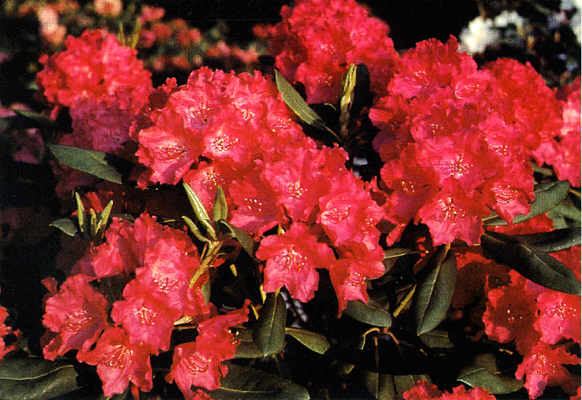
|
|
R. 'Redder Yet'
Photo by Arthur Pride |
'Redder Yet'
- unknown parentage, I think it is an 'America' hybrid from Leach. About the color of 'Nova Zembla' but much more bud and plant hardy. Flowers about June 3.
'Trinity'
- a 'Powell Glass' x
R. yakushimanum
hybrid. Beautiful clear white. Compact plant with excellent foliage. Flowers late May.
'Falling Snow'
- a 'Powell Glass' x
R. yakushimanum
hybrid - beautiful clear white. Compact plant with the darkest rich green foliage of any.
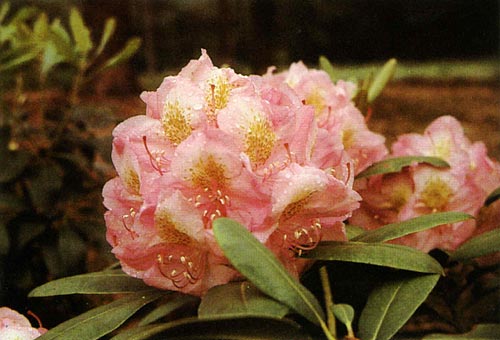
|
|
R. 'Amazing Grace'
Photo by Arthur Pride |
'Amazing Grace'
- a hybrid of 'Mrs. C. S. Sargent' x 'Swansdown'. A shining pink with a large blotch. Original plant is missing, but plant is available from rooted cuttings of flowering size.
'Cloud Twelve'
- a hybrid of 'Mrs. C. S. Sargent' x 'Lodestar' x 'Great Lakes.' A beautiful snow white, compact plant with excellent foliage.
'Pink Touch'
- a hybrid of 'Mrs. C. S. Sargent' x 'Lodestar' x 'Great Lakes.' A beautiful very pale pink. Excellent foliage and plant.
'Ballet'
- a hybrid of B. D. 1005 x
R. catawbiense album
Powell Glass. A beautiful bright pink. Foliage like that of 'Scintillation' and flower.
'Pearce's American Beauty'
- a hybrid purchased from the Pierce Nursery out West years ago. Perhaps the most attractive foliage of any Red hybrid. Plant and bud hardy to 28° below zero. Difficult to root.
The next group of rhododendrons is very plant hardy but either not quite as bud hardy or has not been tested as long.
'Chesterland'
- Named by David Leach. A plant which David Leach purchased from Julien Pot. We think it is a
R. fortunei
hybrid. This plant wintered through in 1977 without any leaf burn. Flower buds were damaged, however. This rhododendron has wintered year after year in an open windswept field and always has near perfect foliage.
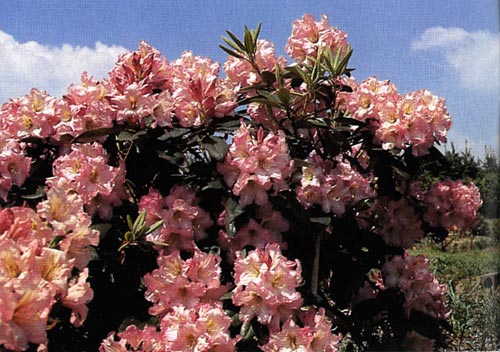
|
|
R. 'Terrific'
Photo by Arthur Pride |
'Terrific'
- An unknown hybrid which I received from David Leach. It was the first large flowered rhododendron that bloomed nearly perfectly for me. The plant has very good foliage, and is a good strong growing plant. Flower color is similar to Caroline Gable but a little more pink. Growing in full sun it simply covers itself with flowers. Very bud hardy.
'Nassua Red'
- A Paul Vossburg hybrid of
R. maximum
, given to me by David Leach. I have had this rhododendron for a good many years and was not too impressed with it. The winter of 1977 it came through with flying colors, and didn't have a leaf or bud harmed by the extreme cold. Blooms about July 1.
'Great Lakes'
- a Leach hybrid of
R. catawbiense album
'Powell Glass' x
R. yakushimanum
'Koichico Wada' F.C.C. This rhododendron should be ahead of most of the previously mentioned ones. I have tested it for many years and it has put on a very good show nearly every year. It, when fully opened, is a very fine white. The plant is excellent with good foliage. It has been a very fine parent for me as well as for others.
'Janet Blair'
- A David Leach selection of a Dexter Hybrid, open pollinated. This rhododendron is a favorite among a great many. Some have it listed along with 'Scintillation.' Our climate is a little too severe some winters when the buds are blasted, but generally it is fairly hardy for us. The plant has never been injured in any way.
'Pink Fondant'
- A hybrid of 'Mars' x R. 'Catalgla' x
R. wardii
which I received from Joseph Gable. It survived the winter of 1977 in an open wind-swept field without any windburn. The buds, however, were blasted. The flowers are an excellent pink with very fine substance, and excellent foliage. It did flower in protected places in the City of Butler in 1977.
'Russell Harmon'
- received my plant from David Leach. It is a natural hybrid of
R. maximum
x
R. catawbiense
. The flower truss is very large and high. Blooms about June 15 and is a pleasing orchid pink. Plant habit and foliage are very good.
'Sam Baldanza'
- A hybrid of ours from seed obtained from Sam Baldanza. It is a cross of 'Mars' x 'America' x 'Flamenco'. A very good red, but difficult to root.
The following rhododendrons are very promising but have been tested for only a few years.
'Blondie'
- From seed given to me from David Leach. A hybrid of ('Neried' x
R. discolor
) x 'Russell Harmon'. A pale yellow, buds good to about -12 degrees F. Plant very compact. Has been a good parent for yellows. Plant has survived -28° F.
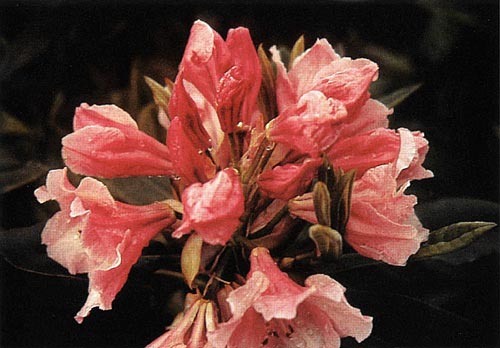
|
|
R. 'Pink Mango'
Photo by Arthur Pride |
'Pink Mango'
- From seed given to me by David Leach. A hybrid of ('Neried' x
R. discolor
) by 'Russell Harmon'. A beautiful orange red with no trace of blue. Flower buds good to about -12° F. Plant has survived -28° F. Have been able to root only a few cuttings.
'Peaches and Cream'
- From seed given to me from David Leach. A hybrid of ('Neried' x
R. discolor
) x 'Russell Harmon'. Flowers to a very pale pink and yellow. Bud hardy to about -12° F. Plant has survived -28° F.
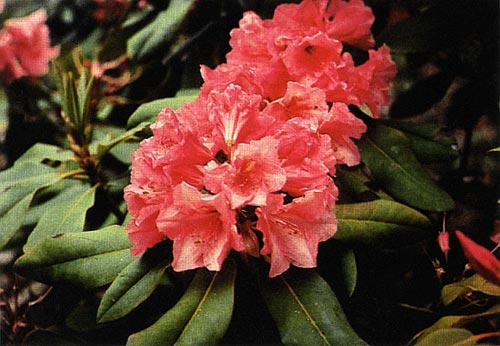
|
|
R. 'Blazen Sun'
Photo by Arthur Pride |
'Blazen Sun'
- (Sunburst) from seed given to me by David Leach. A hybrid of ('Neried' x
R. discolor
) x 'Russell Harmon'. Bud hardy to about -15° F. Plant hardy to -28° F. A brilliant orange red. Large Truss.
'Pink Tipp'
- A hybrid of Pink Icing x
R. catawbiense
'Rubrum' x 'Caroline'. Very compact plant and bud hardy to -28° F. A very delicate white with pink tip.
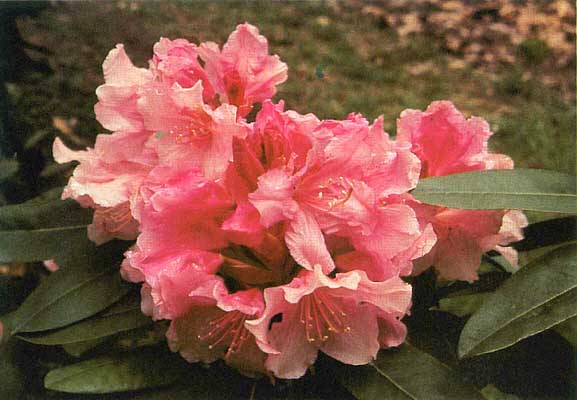
|
|
R. 'Pink Icing'
Photo by Arthur Pride |
'Pink Icing'
- A hybrid of
R. catawbiense
'Rubrum' x 'Catalode' (County of York). Bud hardy to about -10° F. Foliage similar to 'Catalode'. Flowers an unusual clear light pink, which fades almost yellow.
'William Fetterhoff'
- From seed of 'English Roseum' x
R. yakushimanum
, a cross by William Fetterhoff. A beautiful compact plant. Bud hardy to about -15° F. Flowers a beautiful clear light pink. Does not fade like most
R. yakushimanum
hybrids.
'Charles Robinson'
- A hybrid of 'Powell Glass' x 'Vulcan'. A very bud hardy pink. Bud hardy to -28° F.
'Doctor Lewis Santini'
- A hybrid of 'Tahiti' x
R. catawbiense album
'Powell Glass'. A very attractive compact plant and bud hardy to -28° F. Pale yellow flowers on an informal truss.
'Doctor William Fleming'
- A hybrid of 'Boule de Neige' x 'Mount Siga' (
R. vernicosum
Aff. Rock 18139). Beautiful compact plant which is hardy to -28° F. Flowers are pale apricot and perhaps bud hardy to -15° F.
'Orange Honey'
- A hybrid of Blondie x
R. catawbiense album
'Powell Glass'. Plant and bud hardy to -28° F.; 20 florets in truss. Color an unusual orange pink. Similar to 'Mary Belle' only a lighter shade.
'Doctor Bruce Bradley'
- A hybrid of Blondie x
R. catawbiense album
'Powell Glass'. Plant and bud hardy to -28° F. Flowers are alight yellow.
As I reflect on my experiences as a nurseryman over the years, there is one factor which I want to acknowledge. That is the inspiration and help of a number of colleagues. For example, Joseph Gable not only provided a great deal of assistance, but also introduced me to David Leach who, in turn, introduced me to Edmund Amateis, Warren Baldsiefen, Tony Shammarello, and Richard Steele. I also have benefited greatly from my associations with John Wister and Ben Morrison. Research and experimentation in any field is always a demanding and sometimes frustrating endeavor. Only by cooperation, and willingness to help those who share in your love for your particular interest, can you attempt to reach your goal. In hybridizing and research with rhododendrons, I have been especially fortunate to have had the help and friendship of those with whom I have associated during the past 50 years.
It is my hope that this brief summary of my observations, achievements, and failures, will benefit others reaching out to improve one of the most beautiful and, in this part of the world, not sufficiently appreciated plant...the rhododendron.